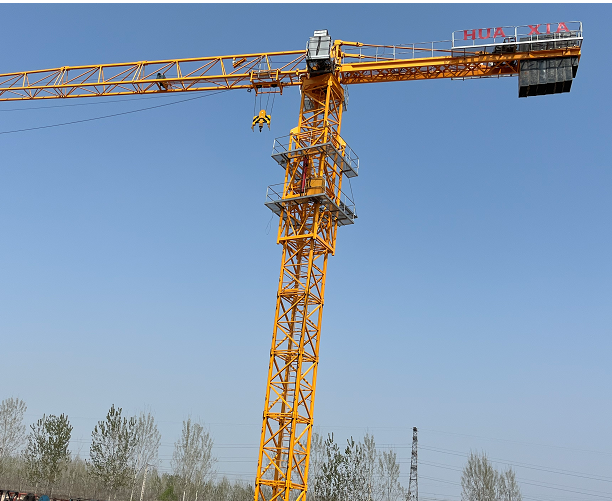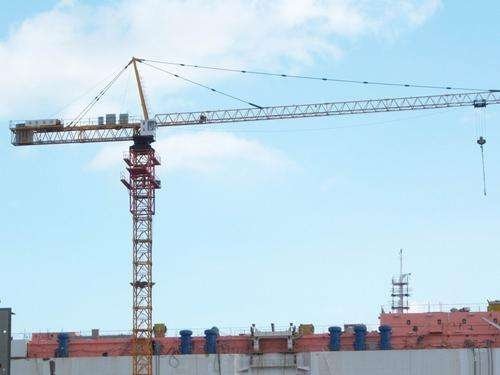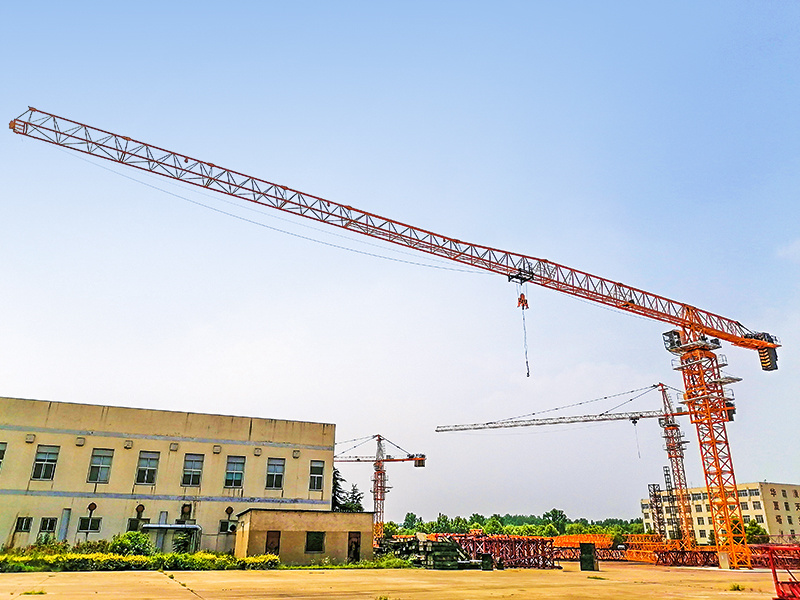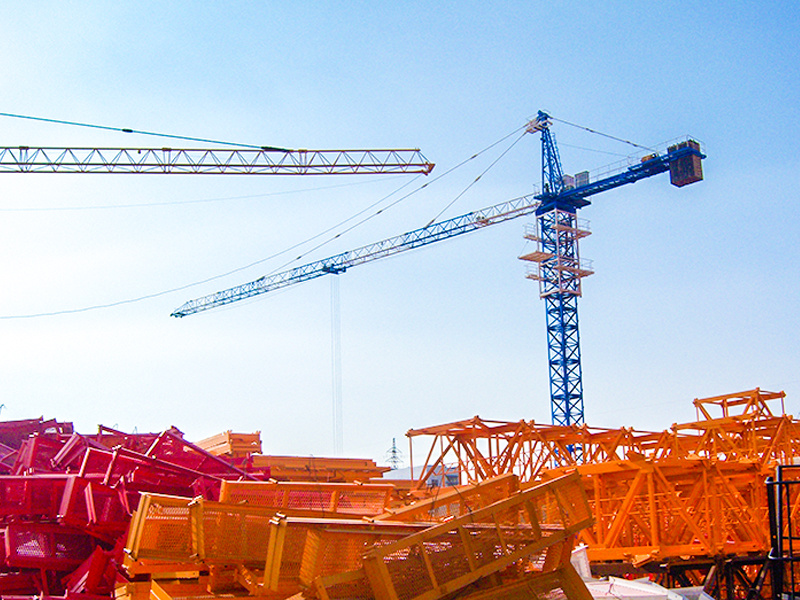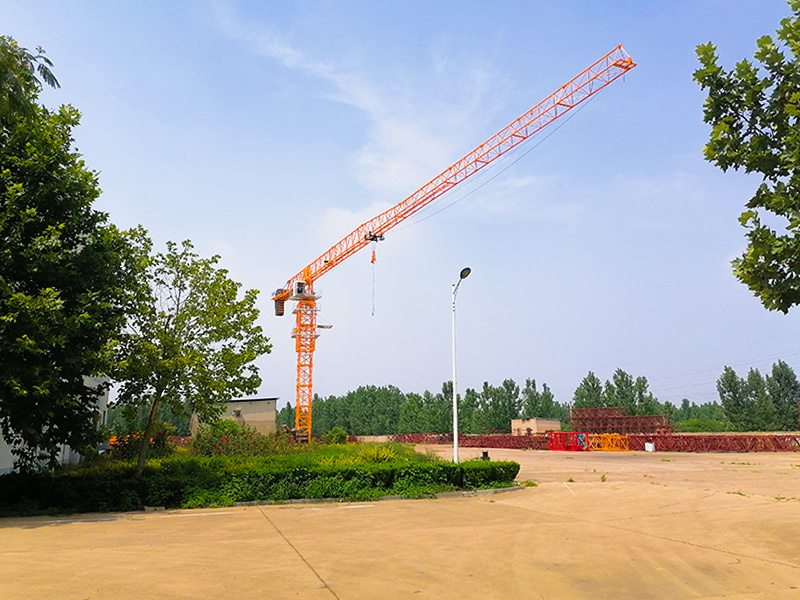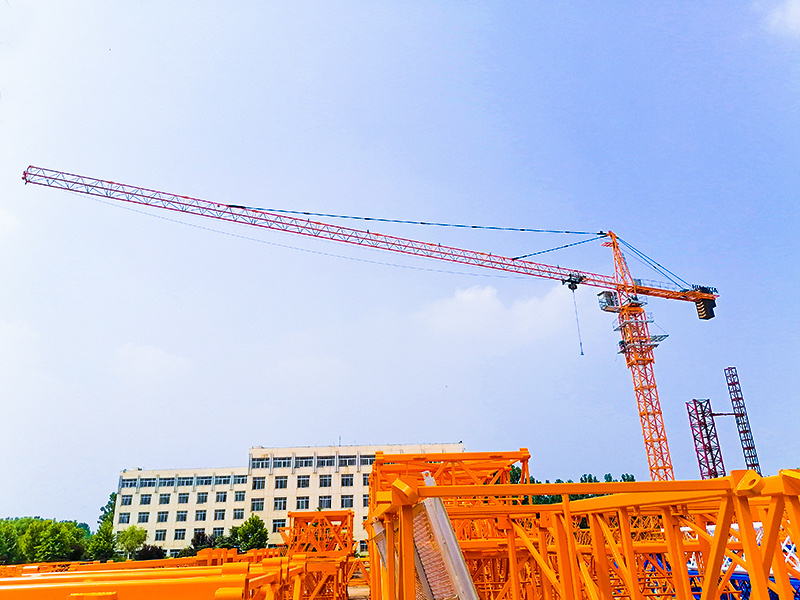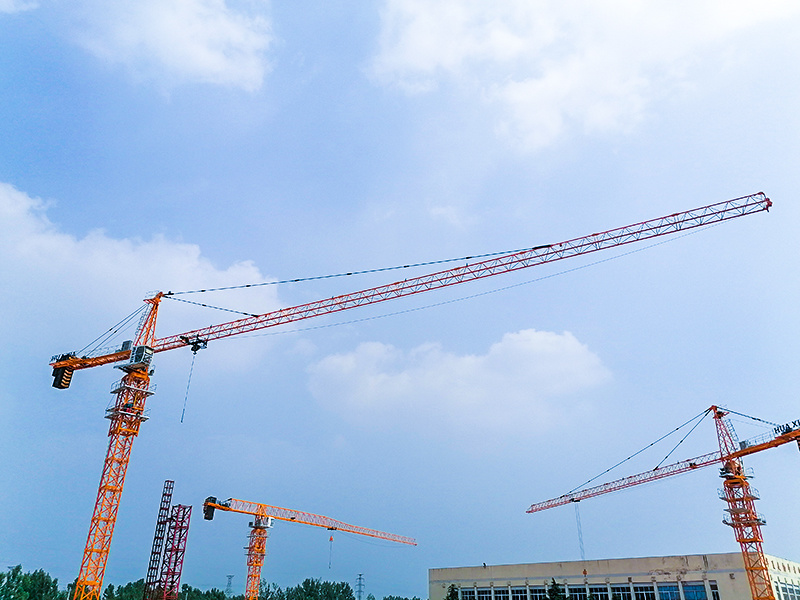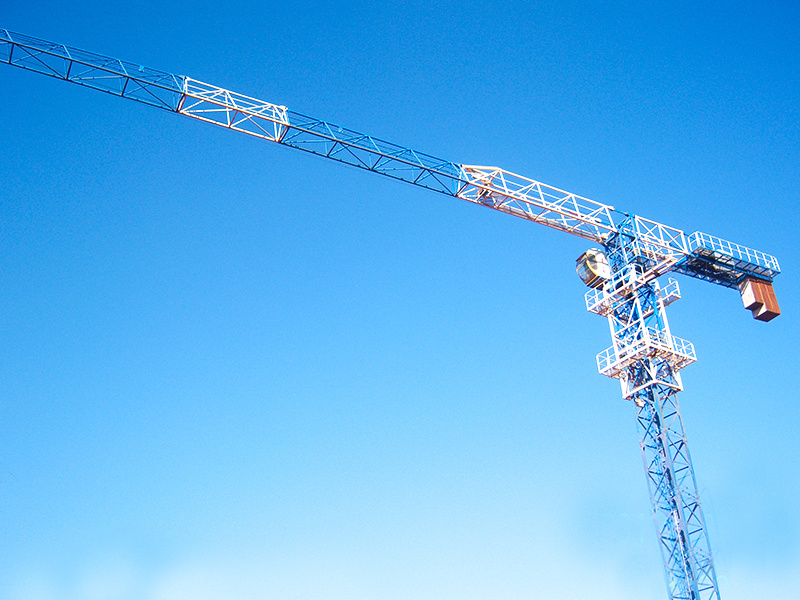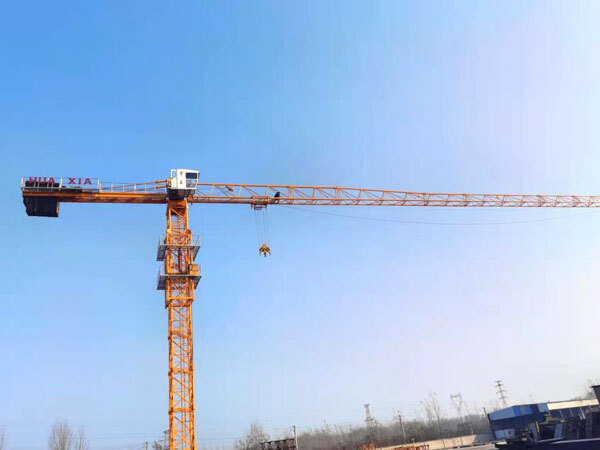2022/05/07
Daily maintenance method of lift
It is safe to use lift lifting equipment for high-altitude work. When using this type of equipment, the specifications and models of the elevator should be strictly controlled. There are many kinds of lifting equipment, and the performance tends to be intelligent.
Tag:
2022/04/24
Huaxia tower crane, also known as "tower crane", is a commonly used lifting equipment on construction sites. Used for lifting steel bars, wooden rods, concrete, steel pipes and other construction raw materials. With the extension of section by section (referred to as "standard section") (height). Huaxia tower crane is an essential equipment on the construction site.
Tag:
2022/04/22
Huaxia tower crane operating procedures
Huaxia tower crane, also known as "tower crane", is a commonly used lifting equipment on construction sites. Used for lifting steel bars, wooden rods, concrete, steel pipes and other construction raw materials. With the extension of section by section (referred to as "standard section") (height).
Tag:
2021/05/25
塔机,即“塔式起重机”简称,又称“塔吊”,是建筑施工中的一种起重设备。 塔机起源于欧洲,第一台原始塔机出现于1912-1914年,1923年制成第一台近代塔机的原型样机,1930年德国开始批量生产塔机,并用于建筑施工。 中国自己生产塔机是在20世纪50年代。1954年,由当时的抚顺重型机械厂仿照试制了我国第一台TQ2-6型塔机,后来相继在上海建筑机械厂、哈尔滨工程机械厂生产。1984年建设部机械局以350万元的价格引进了波坦GTMR360B、TOPKITFO/23B、FO/23B、H3/36B等4种型号的塔机资料和技术培训,由北京建工机械厂、沈建工、四川建机厂负责生产。由于引进对象合理,准备充分,塔机生产在国内迅速展开,为国家建设作出了重要贡献。1984年的塔机技术引进,必将在中国塔机行业发展史上留下重要的篇章。 21世纪初,中国经济又迎来了新一轮的快速增长,房地产业和建筑业成为经济发展新的引擎。在这两个行业的推动下,中国塔机行业出现了难得的发展机遇,一批企业在需求的推动下迅速崛起,不但在国内赢得了市场,更在海外树立了品牌。永茂建机的平头塔机在国内外享有极高的声誉;以“SCM”为标志的川建塔机,被用户誉为“中国第一塔”;中联重科D5200-240塔机项目的签约,不但改写“全球最大塔机”的历史,也将成为全球塔机技术发展的里程碑。 不可否认,伴随房价的快速上涨,中国房地产业的发展引起了各方的广泛关注。2010年初至今,房地产业经历了一系列的严厉调控,整个市场变的小心翼翼,观望情绪不断上升。行业人士应该还清晰记得,2008年4季度,伴随金融危机的袭来,房地产业经历了一轮快速、维持半年的调整,很多开工项目临时停滞,大量的塔机静静矗立在工地上,很多小的塔机企业和租赁商遭到沉重的打击。 塔式起重机tower crane动臂装在高耸塔身上部的旋转起重机。作业空间大,主要用于房屋建筑施工中物料的垂直和水平输送及建筑构件的安装。由金属结构、工作机构和电气系统三部分组成。金属结构包括塔身、动臂和底座等。工作机构有起升、变幅、回转和行走四部分。电气系统包括电动机、控制器、配电柜、连接线路、信号及照明装置等。 塔式起重机分上旋转式和下旋转式两类 上旋转塔式起重机 根据使用要求,又分运行式固定式、附着式和内爬式四种型式。其基本特点是塔身不转动。回转支承以上的动臂、平衡臂部分,通过回转机构和回转支承,能绕塔身中心线作全回转。运行式塔式起重机,整个起重机可沿轨道运行,作业空间大。如将底座固定在轨道上,或不用底座而将塔身直接固定在特制的基础上,就成为固定式塔式起重机,其动臂较长,可以扩大施工作业面积。固定式塔式起重机为了减小塔身的弯矩,在塔身上每隔一定高度用附着杆与建筑物相连,即为附着式塔式起重机(图1 [上旋转附着式塔式起重机])。为了使起重机可随建筑物施工层增高而相应增高,可采用塔身自升装置。塔身自升装置常采用顶升液压缸,液压缸活塞杆通过横梁支承在塔身上。上端推顶起重机的回转部分、外套架以及预先吊置于平台上的待加塔节等向上,上升到一个待加塔节高度之后停止,将外套架支承在塔身上,这时高压油回油箱,活塞杆缩回,将待加塔节推至塔身中心线并与塔身连接,再将活塞杆支承在新加的塔节上,缩短液压缸,使回转部分、外套架等下落至新加塔节上,并与之连牢,塔身即增高一节高度。也可利用建筑物代替下部塔身,将外套架与塔身轮流支承在电梯井内壁的专设的支蹬上,利用液压缸使起重机沿电梯井爬升,称为内爬塔式起重机。内爬式虽省了部分塔身,但对建筑物有特定要求,施工完毕后,拆除工作比较困难。 下旋转塔式起重机 回转支承装在底座与转台之间,除行走机构之外,其他工作机构都布置在转台上,整机重心低。回转支承以上各部分如转台、塔身和动臂等(图2[下旋转塔式起重机])一起回转。因为塔身回转,不能与建筑物附着,故塔身高度比上旋转式低。这种塔式起重机,能整体拆装和转移,既轻便又灵活,使用广泛。 起重机整体拆除和转移时,开动变幅机构,将塔身连动臂下放在汽车上,卸下平衡重,再拉紧变幅绳,底座尾部翘起,推入一轮胎轴,然后将底座支承在轮胎轴上,并用连杆将塔身和底座连牢,即可拖行转移。 较大的下旋转塔式起重机,也常采用塔身自升方式,但由于不能附着,自升高度有限。此外,下旋转塔式起重机,除轨道式之外,还有以履带底盘和轮胎底盘为行走装置的履带式和轮胎式。 设备特点和安全装置 塔式起重机的动臂形式分水平式和压杆式两种。图1 [上旋转附着式塔式起重机]所示起重机的动臂为水平式,载重小车沿水平动臂运行变幅,变幅运动平衡,但动臂自重较大。图2[下旋转塔式起重机])所示起重机的动臂为压杆式,变幅机构曳引动臂仰俯变幅,变幅运动不如水平式平稳,但其自重较小。 塔式起重机的起重量随幅度而变化。起重量与幅度的乘积称为载荷力矩,是这种起重机的主要技术参数。塔式起重机的起升高度大,回转和行走的惯性质量大,故需要有良好的调速性能,特别起升机构要求能轻载快速、重载慢速、安装就位微动。一般除采用电阻调速外,还常采用涡流制动器、调频、变极、可控硅和机电联合等方式调速。 为了确保安全,塔式起重机具有良好的安全装置,如起重量、幅度、高度和载荷力矩等限制装置,以及行程限位开关、塔顶信号灯、测风仪、防风夹轨器、爬梯护身圈、走道护栏等。司机室要求舒适、操作方便、视野好和有完善的通讯设备。 山东华夏集团位于最适合人类居住和创业的城市——山东威海,始建于1985年。经营范围涉及塔机、药业、技能教育、出国劳务、驾驶员培训、酒店服务、旅游等多个领域。 此文章来源于网络如有侵权请联系删除
Tag:
2020/05/05
About the use of tower crane "ten not hanging"
塔机在建筑施工作业中作为垂直运输机械使用很普遍,已成为建筑施工中不可缺少的建筑机械。作为一种大型施工机械,从安全角度分析有以下特点:1、通常具有庞大的结构和比较复杂的机构,能完成一次起升运动、一次或几次水平运动。 2、所吊运的重物多种多样,载荷是变化的。 3、需要直接在较大的范围内运行,活动空间较大。 4、暴露的、活动的零部件较多,且常与吊运作业人员直接接触(如吊钩、钢丝绳等),其潜在许多偶发的危险因素。 5、作业环境复杂。 6、作业中常常需要多人配合,共同完成一项操作。 上述诸多危险因素的存在,决定了起重伤害事故较多,并且塔机一旦发生事故,不仅财产损失而且大多数时候有人员伤害,影响较大,因此已把它归入特种设备管理,从它的制造、安装、使用、维修都发布了相关的规范和规程,相关的部门或单位对其作业中的危险性总结出了起重作业“十不吊”规定,只要坚持了这“十不吊”原则,塔机事故就可以最大限度地避免。但实际生产中具体为哪“十不吊”,业内目前还没有一个科学、具体、实用的版本,塔机相关规范中也没有特别的规定。本文尝试对我地各种版本及塔机的各种规范进行分析归纳,并在此基础上提出关于塔机“十不吊”具体规定,供大家参考。 现将我地流传的相关“十不吊”列举如下: 一、成都市安全监督管理站发布的《施工现场安全管理体系》一书中的塔机“十不吊” : 1、起重臂和起吊的重物下面有人停留或行走不准吊。 2、起重指挥应由技术培训合格的专职人员担任,无指挥或信号不清不准吊。 3、钢筋、型钢、管材等细长的材料和多根物件必须捆扎牢靠,单头“千斤”或捆扎不牢靠不准吊。 4、多孔板、料斗、手推翻斗车不用四点或大模板外挂板不用卸甲吊时不准吊。预制钢筋混凝土楼板不准双拼吊。 5、吊砌块必须使用安全可靠的砌块夹具,吊砖必须使用砖笼,并堆放整齐,木砖、预埋件等零星物件要用盛器堆放稳妥,叠放不齐不准吊。 6、楼板,大梁等吊物上站人不准吊。 7、埋入地里的板桩、井点管等以及粘连、附着的物件不准吊。 8、多机作业应保证起吊重物距离不小于3m,在同一轨道上多机作业,无安全措施不准吊。 9、六级以上强风不准吊。 10、斜挂重物或超过机械允许荷载不准吊。 上述中第一条,“在臂架下面有人停留或行走不准吊”,在施工现场中这一条肯定是无法避免的,因为当塔机吊物旋转过程中几乎要覆盖整个现场,臂架下肯定会有人停留或行走;“吊起的重物下面有人停留或行走不准吊”中已经自相矛盾,已经起吊了还要求不准吊,所以这一条无多大意义。第四条中,料斗大概是塔机自配的专用料斗,这必须用四点吊,但手推翻斗车怕是禁止用来吊运材料的了,所以这一条也应该修改;其余几条只说明了一些特殊性,不完全。 二、成都市安全监督管理站出的《民工夜校读本》中的塔机“十不吊” 1、超载和斜拉不准吊。 2、散装物装得太满或捆扎不牢不准吊。 3、无指挥、乱指挥和指挥信号不明不吊。 4、吊物边缘锋利无防护措施不吊。 5、吊物上站人和堆放零星物件不吊。 6、埋在地下的构件不准吊。 7、安全装置失灵不准吊。 8、雾天或光线阴暗看不清吊物不准吊。 9、高压线下面或离高压线过近不准吊。 10、六级以上强风不吊。 上述中对小型物件如砖块、箍筋等无要求,第八条的雾天与第十条都属于同类性质“恶劣天气”,所以需补充和完善。 三、四川省安全生产管理局出的培训教材《建筑施工现场安全生产管理体系》中的塔机“十不吊”: 1、超负荷不吊。 2、指挥信号不明、光线不明、重量不明不吊。 3、吊索和附件捆绑不牢、不符合安全要求不吊。 4、歪拉斜挂、埋在地下物件不吊。 5、安全装置不灵不吊。 6、靠近高压线又无可靠安全措施不吊。 7、物件上站人或上有活动物品不吊。 8、易燃易爆品不吊。 9、带棱角快口物件未垫好不吊。 10、违章使用、违章指挥时不吊。 上述中同样对小型物件无要求,对恶劣天气只在第一条中说了一下“光线不明”,也不完善,第八条中“易燃易爆品”较笼统,比如施工现场中的木方、泡沫等都属于易燃易爆品,那肯定是要吊的,还有氧气、乙炔瓶在主体施工时二、三十层楼如不用塔机吊上去,用人抬上去吗?这条也值得商榷。第十条中“违章使用”一项较笼统,本身十不吊就是指出哪些是违章使用,所以这一条是凑上去的。 四、塔机相应规范中的“不吊”(或禁止作业的项目): 1、《建筑机械使用安全技术操作规程》(JGJ33-2001)中第4.4.40条要求:作业中如遇六级及以上大风或阵风应立即停止作业; 2、《塔式起重机操作使用规程》(JT/T100-1999)中第3.1.10条要求:在作业中有下列情况之一者,司机不得操作起重机, (1)、指挥信号辨别不清;(2)、会造成事故的指挥;(3)、不符合起重机性能的指挥。 3、第3.1.11条,在作业中有两个或两个以上的指挥人员,只有一个指挥人员发出信号时,方可操作。凡是有两个或两个以上指挥人员同时发出信号时,不得操作。 4、第5.2.1条:司机必须熟悉所操作的起重机的性能,并应严格按说明书的规定作业,不得斜拉、斜扯重物、吊抜埋在地下或粘连在地面、设备上的重物以及不明重量的重物。 5、第5.2.6条:司机不得操作安全装置失效、缺少或不准确的起重机进行作业。 6、第5.2.8条:不允许起重机超载或超风力作业。 7、第5.2.13条:不得起吊带人的重物,禁止用起重机吊运人员。 8、5.2.16条:作业中遇下列情况应停止作业:(1)、恶劣气候,如大雨、大风、大雾,超过允许工作风力等影响安全的作业;(2)、起重机出现漏电现象;(3)、钢丝绳磨损严重、扭曲、断股、打结或出槽;(4)、安全保护装置失效;(5)、各传动机构出现异常现象和异响;(6)、金属结构部分发生变形;(7)、起重机发生其他妨碍作业及影响安全的故障。 根据上述,第一条指的恶劣天气;第二、三条指的是指挥信号方面;第四条指的是起重量方面的;第五条指的是安全装置方面;第六条指的是指的是起重量和天气方面;第七条指的是不准载人;第八条的第一项指的是天气方面,后面几项指的是安全装置方面。 五、根据以上分析,提出笔者总结的“十不吊”: 1、歪拉、斜挂重物不吊。 2、超起重机额定负荷不吊。 3、埋在地下或粘连在地面、设备上的重物及不明重量的重物不吊。 4、无指挥、乱指挥和指挥信号不明不吊。 5、小件物品未用吊笼(蓝)装或未装平整、超过吊篮边沿不吊。 6、起吊物上站人或上有活动物品不吊。 7、起吊物和附件捆绑不牢或捆绑不符合安全要求不吊。 8、吊物边缘锋利、带棱角等无防护措施不吊。 9、安全装置失灵不吊。 10、大雨、大雪、大雾、六级以上大风等恶劣天气不吊。 以上就是笔者根据各种版本及相关规范总结出来的“十不吊”, 有不足之处请大家批评指出,互相学习,或者经过本文的抛砖引玉,共同商讨,使塔机的“十不吊”形成规范性文件。
Tag:
2020/02/04
Several Factors Causing Tower Crane Accidents
塔式起重机因其使用的特殊性和结构,其安全隐思存在于安装、使用、管理、自然环境等诸多因素中。 (1)塔式起重机的自身结构因索 塔式起重机钢结构的刚度、稳定性、强度直接影响塔式起重机的安全性。由于起重机在作业过程中受频繁的交变载荷作用,极易使钢结构友生疲劳破枫。如使塔式起重机腹杆焊缝开裂、母材断裂、变形、弯曲等,使结构的刚廑、稳定性、强度降低,使钢结构发生瘦劳破损,破坏钢结构的局部稳定性.引友事故。 (2)电气系统、机构的且素 塔式起重机的工作机构采用电气俸动与控制,优点是控制方便、节傩、成本低等.同时电气元件易实现标准化和通用化,维侈更换方便,易实现各种安全保护。机构电气系统工作状态的好坏,决定着塔式起重机的可靠性、安全性和使用性能.如有损坏和异常.则可能导致事故的发生。如电气系统故障,可导致机构产生冲击振动,造成断轴、断齿而引友事故。离合器、制动器损坏或矢控,可能造成冲车和重物坠落事故。电气绝缘老化或橱坏可能导致触电事故。各种安全装置失效,可能导致倒塔、折臂和重物坠落等事故。如幅度限位或行程限位失效,可能造成大车或小车冲车以至脱轨事故。超载限制器和力矩限制器失效,可能折臂和倒塔事故。 高度限位器失效,可能导致钢丝绳过卷迨成断绳和重物坠落事故。相序保护矢救,在错相和断相情况下.可能造成操作指令紊乱而引发事故。 (3)人为的因素 在诸多塔式起重机事故中。多数事故是因为使用者违章操作或误操作。下面提到的两起事故也有违章操作的因素。 某单位非司机不响铃开车。结果把在轨道上进行维侈的工人压伤。某机械施工公司安装队在检侈TQSOB型塔机时,为更换起重臂拉扳销于,准备先把平衡重取下再换拉板销子,把起重臂与起重绳连结在一起,然后用汽车吊起起重臂。打开起重臂拉板销子,在放下吊臂时,由于平衡重产生的向后倾翻力矩很大,使塔机失去平衡造成平衡臂连同塔尖一起坠落。 拆装过程事故。由于塔身金属结构体高重量大,塔机拆装属高空作业,危险性大,技术性强。在塔机事故中,拆装过程发生的事故占相当大的比例,且都是比较大型的事故。有的塔机拆装不是请专业安装队完成而是由非专业人员来完成。由于安装人员素质不高,没有编制安装方案的能力,没有进行方案选择和力学计算的能力,没有制订科学拆装的能力,这样解决不了作业过程中的新问题或特殊问题,发生事 故是必然的。有的安装质量不合标准,留下了事故隐患。 管理不当。主管单位和安全部门对工作人员培训不够,对各项规章制度理解和施行不够以及对工作现场管理不够等都为事故发生埋下了隐患。有的企业制度不健全,工作人员无章可循,只好凭个人经验进行作业,易出差错;有的企业未施行专人专机,加上各厂机型不同,操作手柄布置不一。所以司机就有可能操作失误;有的工地为了工作需要,把一些工作人员临时组合作业,使指挥、司机、司索人员难以达到作 业协调一致,有的非专业人员或领导临时充当作业人员,不免出现错误和事故;有的企业不注重检修管理,没能把事故隐患消灭在萌芽状态。 (4)自然因索 所谓自然因求丑指人们未能颈见且突发的危害冈索,不以人的意志为转移,有的是不可抗拒的灾害。象地震、洪水、台风.可亩接或间接造成粤故。如塔式起重机制造过程中,结构件残存的内应力过大,使用中应力集中处在外力作用下结构局部应力剧增以至发生构件突然断裂,导致事故,对使用者来说也是不可预见的。还有使用普通结构钢制造的塔式起重机在零下20℃以下作业,会产生脆性断裂,导致受力 构件折断。电网供电电压过低,系统电压降过大,造成电气控制失灵,导致机构失控引发事故。 还有其他因素也可能引发事故,如塔式起重机与高压线或临近的建筑物的安全距离不够,会导致触电或碰撞事故。 塔式起重机基础承压不够,可导致基础失稳,引发倒塔事故。 吊物捆扎不合理或悬挂不利会导致重物坠落事故。塔式起重机的护圈、护栏及安全平台的安全防护措施不符和要求,可能造成人员坠落事故。上述因素都是造成事故的原因,只有遵章操作,加强设备的维护保养,才能消除隐患,确保安全生产。
Tag:
2020/01/07
Maintenance of tower crane slewing bearing device
(1) The mounting support of the slewing bearing (the seat on the lower bottom surface of the ring gear and the seat on the upper surface of the inner seat ring) must have sufficient rigidity, and the mounting surface must be flat. Before assembling the slewing bearing, the bearing should be treated with stress relief to reduce the deformation of the slewing bearing. The contact surface between the support and the slewing bearing must be cleaned during assembly. (2) In use, attention should be paid to the change of noise and the change of rotation resistance torque. If there is any abnormal phenomenon, it should be disassembled and inspected. (3) The slewing bearing must be lifted or stored horizontally, and must not be lifted or stored vertically to avoid deformation. (4) Before the bolts are completely tightened, the meshing inspection of the gears should be carried out, and the meshing condition should meet the requirements of gear accuracy: that is, the contact spots distributed on the tooth surface after the gear pair is running under slight braking are not less than 25% in the height direction of the gear teeth, and not less than 30% in the length direction of the gear teeth. (5) The sundries shall be removed once for 10 shifts of tooth surface work, and grease shall be applied again. (6) In order to ensure the reliability of bolt work and avoid insufficient bolt pre-tightening force, the bolt pre-tightening torque should be checked separately after the first 100 hours and 500 hours of slewing bearing work. The pre-tightening torque shall be checked every 1000 hours thereafter. (7) The bolts and nuts connecting the slewing bearing are all high-strength bolts and nuts; double nuts are used for fastening and anti-loosening. (8) When tightening the nut, the thread of the bolt and the end face of the nut should be coated with lubricating oil, and the torque wrench should be used to tighten the nut several times symmetrically and evenly in the circumferential direction. When tightening the last time, the pre-tightening torque on each bolt should be approximately uniform. (9) 4 oil cups are evenly distributed on the upper surface of the ring gear of the slewing bearing aligned with the raceway, thus adding grease to the raceway. In general, the slewing bearing is lubricated once every 50 hours. Fill the oil every time until the grease seeps from the seal.
Tag:
2019/08/27
Energy saving, energy reduction, efficiency and income for development
In response to the call of building a conservation-oriented society and saving energy and reducing consumption, Linyi Huaxia Heavy Industry has continuously improved its internal management level, fully tapped its internal potential, vigorously implemented energy-saving and potential-tapping measures, reduced production costs, and improved economic benefits. In order to save all kinds of production resources, we insist on saving energy from bit by bit, and take the activity of "saving one kilowatt-hour of electricity, one drop of water, one piece of paper, one drop of oil and one cent" as a long-term project. frugal behaviors such as double-sided printing of informal manuscripts and turning off the lights have become a habit and a norm in the work and life of the majority of employees, do timely turn off the power and in accordance with the operating procedures to operate a variety of equipment, greatly reducing the consumption of various materials. In order to effectively reduce the consumption of raw materials, our company strictly controls the admission acceptance and processing quality in the procurement and production of raw materials to ensure that the raw materials are used with high quality and efficiency. For the management of the company's vehicles, the company sets fuel consumption standards per 100 kilometers and gives negative incentives to drivers who exceed the fuel consumption standards. At the same time, the vehicle speed is monitored by the monitoring system to prevent the phenomenon of driving fast, improve vehicle performance and reduce abnormal maintenance costs. A series of energy-saving measures implemented by the company have effectively reduced the level of energy consumption, reduced production costs, improved economic benefits, and enhanced the company's market competitiveness to a certain extent. The company will continue to implement energy-saving work to promote sound and rapid development.
Tag:
2019/07/07
In view of the tower crane production, supply and marketing, the use of the chaotic situation, some formal enterprises put forward their own suggestions. Xia Chunting, member of the Standing Committee of the CPPCC Provincial Committee and chairman of Huaxia Group, talked about his own views. His suggestion is to take advantage of the new license renewal next year to revoke the production licenses of a number of manufacturers that no longer have the production conditions. For enterprises that want to join the tower crane production industry, can they implement the practice of obtaining a license before obtaining a business license, just like pharmaceutical factories. It is understood that the tower crane production license is changed every five years, and now the national license has expired last year, and the state wants to start the replacement work next year. In response to this proposal, Liu Hongsheng, director of the production license department of the AQSIQ, said in an interview with our reporter on September 24 that the AQSIQ will start the renewal work next year. Before the renewal, the AQSIQ will set up an examination department, which will be responsible for organizing experts to prepare the detailed rules for the implementation of the renewal. Director Liu said that after the replacement work is completed, the State Administration will organize a nationwide rectification activity to ban unlicensed enterprises. Wu Jianping, director of the Production License Office of the General Administration of Quality Supervision, Inspection and Quarantine, added that companies may resort to fraud for a while in order to obtain a license, and once found out, they will be revoked forever. Some enterprises suggest that the annual inspection and supervision system of tower cranes should be strictly used to strengthen the management of operators. It is understood that the operation risk of tower cranes is higher than that of cars driving on the road. The annual inspection and scrapping system of cars and the qualification examination of drivers are extremely strict, but this is not the case with tower cranes. The annual inspection is a mere formality, and there is a chaotic situation of cross-management of departments in some areas. In addition, nearly half of the tower crane accidents occur during installation or disassembly. The main reason for this accident is that the quality of installation personnel and operators is not high. At present, people who do not have a tower crane driver's operation license also open tower cranes, lacking strict management. On September 24, Cui Gang, director of the Special Equipment Division of the Boiler Bureau of the General Administration of Quality Supervision, Inspection and Quarantine, told reporters that in the past, due to the fact that there was a cross-management situation of "everyone is in charge of everyone", the safety supervision of the use of tower cranes in use was in disorder. state. He introduced that the State Council once again clearly stipulated in the three-set plan of the General Administration of Quality Supervision, Inspection and Quarantine issued in August this year that in the future, the annual inspection of tower cranes and the security inspection of newly installed tower cranes and the training of operators will be organized by the quality inspection system, and other administrative departments shall not interfere. Cui Gang said that starting from October 1 this year, the quality inspection system will strongly enter the security inspection link of tower cranes in use, and strictly train and issue certificates for drivers. From July 1, 2001, the use of 20D derrick tower crane is prohibited, because this simple tower crane, which was mass produced in the early 1990 s, has great hidden dangers. It was suggested that the practice should also be replicated throughout the country. For the 20D derrick tower crane, if there are serious safety hazards, relevant experts should consider this issue when preparing the implementation rules for the replacement of certificates, and put forward the "national production ban" proposal. Xia Chunting also suggested that from the perspective of safety performance, the state should promote basic tower cranes and minimize or even ban the two types of tower cranes, heavy and walking. Regarding this proposal, Director Liu Hongsheng said that we will fully consider how to strengthen the safety performance requirements of heavy and walking tower cranes in the detailed rules for the implementation of the renewal of certificates, but the complete ban on these two types of products must be carried out with the cooperation of other departments of the State Council.
Tag:
2019/06/02
Several problems should be paid attention to in tower crane demolition
随着建筑工程逐步向高大,短工期方向发展,塔式起重机在建筑施工中的拆迁日益频繁,装拆成了一个十分重要的工作环节。笔者根据十年的工作经历就塔机拆迁中应注意的几个问题与同仁商榷,以求共提高。 1 安装现场选择 在已选好塔机型的前提下,安装现场选择应处好以下事项:①一次安装能完成整体工程施工,避免出现二次移位;②避免施工平面上出现死角;③固定式附着点的选择及安装方便;④施工完成塔机拆卸及运输方便;⑤施工空间内避开其分建筑物、高压电网等;⑥根据施工需要有助于安装其它设备及起吊建筑构件。 2 人员组织 塔机装拆是一个既重要又危险且紧张的立体作业工程,必须从思想上引以高度重视,从组织上得到充分保证。除配备必要的施工管理与专业技术人员外,所有施工作业人员应经过专业教育,具有相应工种安全知识、操作技能,持证上岗。塔机装拆施工应由专业施工队进行。 3 讨拆施工设备和机具准备 3.1 应注意的问题 塔机迁移一般涉及拆卸、运输、安装等多环节,对设备和机具必须精心的组织安排,既要保证安全,又要提高要效和经济效益。应注意:①所有起重安装设备既避免大材小用,又不许超载能力使用;②运输设备应根据塔机各零部件的质量、外形尺寸等安排,尽量避免超长,超高,超宽,超重运输;③尽量采用边拆卸,边装车运输,边安装的施工方法,避免二次倒运或占用不心要的施工现场 ;④现场应配备工肯或救护车,高空作业还须配备必要的通讯工具有利安全作业、正常施工。 3.2 起重吊具索具的选择 塔机装拆施工一般应配备白麻绳或尼龙绳,各种规格的钢丝绳套、钢索,一定数量的8#铁丝及专用工具。这些用具诮具有足够的许用拉力和安全系数,不同性能吊具,索具须按相应标准使用和报废。 3.3 设备零部件的清点与准备 施工中缺件、少件等影响进度的现象屡见不鲜,为保证施工进度应对以上部件加强管理,检查和维修;设备专用较小配件、散件;专用、通用螺栓、母、垫;各种规格和数量的联接销、轴;设备装拆所配用的专用工具;部分结构件损坏变形的修整工具;钢丝绳卡、绳环等。 4 塔机基础 塔机安装前必须保证有一个正确、完好的基础,塔机基础为固定基座式和轨道行走式两种,应注意以下问题。 1)基础地面承载能力是基础的基础,应采取必要的措施保证地面承载力为10-20t/m2。可以采用3:7灰土夯实或压实等方法施工。切忌对回填土与垃圾等不做处理而直接用做基座或轨道。 2)固定基座应按设计要求施工,保证各部尺寸特别是预埋螺栓等必须保证基础中心至建筑物间尺寸的要求,以便建筑施工和附着安装。 3)轨道式基础应按设计要求施工,保证碎石厚度、路基宽度、枕木间距、铁轨型号、铁轨接头、连接拉杆,车挡、接地等技术要求。 4)塔机基础下不得有暗沟、防空洞等,应设有必要的排水设施。 5)地面上应安装塔机,地下工程施工时应保证塔机距基坑边起的距离。 5 塔机的安装与拆卸 5.1 装拆前准备 塔机的装拆是施工的中心环节,危险性很大,施工前必须做好充分准备:①技术员应根据安装使用说明书和施工的具体特点做好施 工方案或施工组织设计,并具有安全技术交底的内容。施工方案必须在作业前传达到所有施工人员,切忌走过场;②施工方案应对重点、难点部位的装拆方法做详细的计算和论述,有明确的施工方法,选择正确的设备、吊索具、吊点、捆扎方法等。 5.2 装拆作业 旗工过程必须做到统一思想,统一指挥,按有关安全使用操作规程施工。应注意:①施工用起重设备支腿应打在牢固的地面上,垫必要的木板或方木;②斜吊、侧吊、抬吊选择适当的的吊点位置和辅助牵引等措施;③2m以上的高空作业须有安全保护,雨天及风力大于五级时停止作业,施工中途遇风雨时必须将塔机安装处于安全状态;④升降作业时起重臂决不得转向,并设专人保护;⑤装拆必须严格按施工方案所要求顺序进行,安装起重臂前沿不应加配重,未装配重不得起吊重物。拆卸时应先拆配重后拆起重臂;⑥检查塔机各连接部件是否齐全、可靠、有效,其吊、索具等上否安全。 5.3 吊点的选择 塔机装拆施工中吊点的选择和装拆方法是保证安全施工的重要环节,应注意几个问题。 ①各部件吊点应尽量使用固定位置或专用吊点,必要时可以由自己设计配置。侧吊、斜吊时应保证其合理的倾角。有内外套结构件时吊点应选在内套结构上,避免内外分离,如TQ60/80塔机塔尖。②起重臂和平衡臂等部件起吊后应尽量保证其水平和方向性,较长起重臂的安装尽量采用长度方向非水平起吊的方法,即安排臂的铰接端高于臂头端,铰接后再将起重臂安装至水平位置,如FO/23B塔机50m起重臂等。③塔机起重臂为前后两部分铰接成一体,装拆时吊点应选择尽量使臂水平,临时连接绳受力较小的位置。④拆卸是安装的反向作业,更具有危险性,应严格按施工方案的装拆说明书上各自顺序作业,切不可颠倒顺序。⑤尽量不使用钩子加绳索起吊重物。 6 塔机的检验与调试 检验和调试是塔机安装施工的最后一道工序,也是塔面使用前的最后一道关口,因此检验与调试同样是一项很重要的工作。应注意:①对整机各部位检查必须完整细致,发现问题及时解决;②检验调试中应同时做好各部位的维护保养工作;③塔机各工作机构应运行正常,各安全防护装置应齐全有效;④整机检验调试应做好记录以备塔机的验收。 7 管理制度的制定 塔机的安装拆卸是一项系统性很强的管理施工工程,我单位根据多年的经验和教训制定了一套比较系统完速的管理措施,从组织上、制度上得到充分保证。对管理施工的各环节制定比较细致的规定,如塔机基础验收规定和技术档案、安装拆卸任务书、安装拆卸安全技术交底、轨道验收记录、装拆施工记录,装拆完毕检验记录、零部件清点记录、使用安全技术交底等,实践证明行之有效。
Tag:



